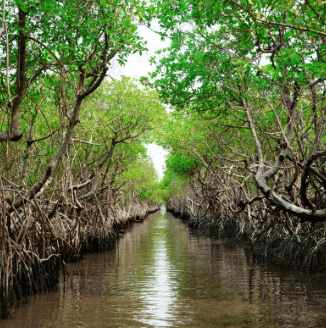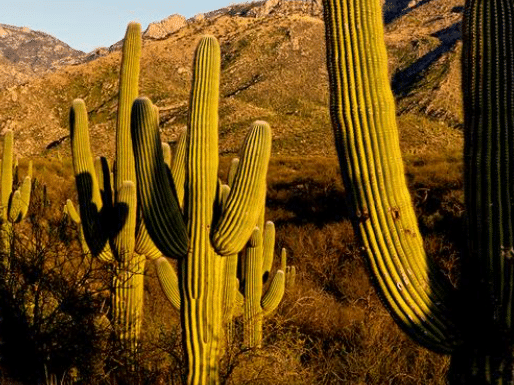Adaptations in Plants - 2 Class 6 Worksheet Science
| Table of contents |

|
| Multiple Choice Questions (MCQs) |

|
| Fill in the Blanks |

|
| True or False |

|
| Match the Following |

|
| Answer the following questions |

|
Multiple Choice Questions (MCQs)
(i) Plants living in deserts need to reduce the loss of water because water is very scarce in deserts. Which of the following is an adaptation developed by the desert plants to manage the above situation?
(a) They have lots of branches and leaves.
(b) They do not shed leaves in the summer.
(c) They develop roots that come above the ground.
(d) Their leaves are modified into spines.
Ans: (d) Their leaves are modified into spines.
(ii) Plants in hilly areas have to bear high-speed winds and cold Which of the following adaptations best helps them face the above conditions? 
(a) Having lots of branches and leaves.
(b) Tall and straight trunk with needle-like leaves.
(c) Leaves that are modified into spines.
(d) Breathing roots that come above the ground.
Ans: (b) Tall and straight trunk with needle-like leaves.
(iii) What type of roots do plants in marshy or swampy areas develop to survive?
(a) Taproots.
(b) Fibrous roots.
(c) Breathing roots.
(d) Adventitious roots.
Ans: (c) Breathing roots.
(iv) Which of the following is a characteristic of fixed aquatic plants? 
(a) Floating on the surface of the water.
(b) Roots fixed to the bottom of the water body.
(c) Completely submerged underwater.
(d) None of the above.
Ans: (b) Roots fixed to the bottom of the water body.
Fill in the Blanks
(i) The place where an organism usually lives and grows in nature is called its __________.Ans: The place where an organism usually lives and grows in nature is called its habitat.
(ii) __________ are special features that help a plant to survive in its habitat. Ans: Adaptations are special features that help a plant to survive in its habitat.
(iii) Plants that grow in water are called __________ plants.
Ans: Plants that grow in water are called aquatic plants.
(iv) __________ trees do not lose their leaves at once and are green throughout the year.  Ans: Evergreen trees do not lose their leaves at once and are green throughout the year.
Ans: Evergreen trees do not lose their leaves at once and are green throughout the year.
(v) Roots that grow out of the soil to breathe from the air are called __________ roots.
Ans: Roots that grow out of the soil to breathe from the air are called breathing roots.
True or False
(i) Plants in deserts store water in their stems or leaves. (True/False)Ans: True
(ii) Underwater plants have broad leaves to float on water. (True/False)
Ans: False
(iii) Plants in plains usually have needle-like leaves. (True/False)
Ans: False
(iv) Mangroves are examples of plants that grow in marshy areas. (True/False)  Ans: True
Ans: True
(v) Floating plants have lots of empty spaces filled with air to stay light. (True/False)
Ans: True
Match the Following
 Ans:
Ans:
Answer the following questions
(i) What is a habitat?
Ans: A habitat is the place where an organism usually lives and grows in nature. It contains everything an organism needs and can be as small as a garden patch or as big as a forest.
(ii) What are adaptations in plants?
Ans: Adaptations are special features that help plants survive in their habitats. For example, desert plants have spines instead of leaves to reduce water loss.
(iii) What are the three types of aquatic plants? Give examples.
Ans: The three types of aquatic plants are:
- Floating Plants: Examples include duckweed, Wolffia, Pistia, and water hyacinth.
- Fixed Plants: Examples include lotus and water lily.
- Underwater Plants: Examples include Hydrilla, eelgrass, and Vallisneria.
(iv) How do fixed aquatic plants adapt to their environment?
Ans: Fixed aquatic plants have roots fixed to the bottom of the water body and long, thin, flexible stems. Their leaves have a waxy coating to stay dry and stomata on the upper surface for gaseous exchange.
(v) What adaptations help desert plants survive in their habitat?  Ans: Desert plants have the following adaptations:
Ans: Desert plants have the following adaptations:
- Store water in their stems or leaves.
- Long root systems to absorb water deep underground.
- Leaves are reduced to spines to prevent water loss and discourage animals.
- Waxy coatings reduce water loss.
- Photosynthesis occurs in the green stem.
(vi) Why are trees in mountains cone-shaped and have needle-like leaves?
Ans: Trees in mountains are cone-shaped to allow snow to slide off easily. Their needle-like leaves prevent water loss and shed snow efficiently.
(vii) What are breathing roots, and where are they found?  Ans: Breathing roots are roots that grow out of the soil to take in air. They are found in marshy or swampy areas, and examples include mangroves like Rhizophora and Avicennia.
Ans: Breathing roots are roots that grow out of the soil to take in air. They are found in marshy or swampy areas, and examples include mangroves like Rhizophora and Avicennia.
(viii) What is the role of underwater plants in supporting animal life?
Ans: Underwater plants release oxygen during photosynthesis, which supports aquatic animals. They also filter sunlight to prepare food.
(ix) What advice is given to reduce the use of paper?
Ans: To reduce paper use:
- Reuse paper whenever possible.
- Use both sides of the paper.
- Avoid plucking leaves and flowers as they are homes to insects and small animals.
(x) What contribution did Charles Darwin make to science?
Ans: Charles Darwin wrote the book On the Origin of Species, where he explained that all plants and animals have evolved from earlier forms of life. He made significant contributions to the study of evolution.
|
49 videos|156 docs|34 tests
|
FAQs on Adaptations in Plants - 2 Class 6 Worksheet Science
| 1. What are some common adaptations in plants to survive in different environments? |  |
| 2. How do plants adapt to low light conditions? |  |
| 3. What are some examples of plants that have adapted to extreme temperatures? |  |
| 4. How do plants adapt to limited water availability? |  |
| 5. How do plants adapt to nutrient-poor soil? |  |





















